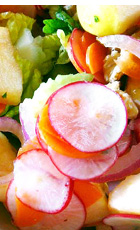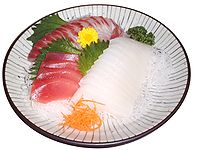Raw Food Diet No Grains
Diet of uncooked and unprocessed food
This article is about raw food consumption in humans. For a raw diet for cats or dogs, see Raw feeding.

The Japanese sashimi is a raw dish, usually consisting of fresh raw fish.

Raw foodism, also known as rawism or following a raw food diet, is the dietary practice of eating only or mostly food that is uncooked and unprocessed. Depending on the philosophy, or type of lifestyle and results desired, raw food diets may include a selection of fruits, vegetables, nuts, seeds, eggs, fish, meat, and dairy products. The diet may also include simply processed foods, such as various types of sprouted seeds, cheese, and fermented foods such as yogurts, kefir, kombucha, or sauerkraut, but generally not foods that have been pasteurized, homogenized, or produced with the use of synthetic pesticides, fertilizers, solvents, and food additives.
The British Dietetic Association has described raw foodism as a fad diet.[1] [2] Raw food diets, specifically raw veganism, may diminish intake of essential minerals and nutrients, such as vitamin B12.[1] [3] [4] Claims held by raw food proponents are pseudoscientific.[5] : 44
Varieties [edit]
Raw food diets are diets composed entirely or mostly of food that is uncooked or that is cooked at low temperatures.[3] [4] [6]
Raw animal food diets [edit]
 Steak tartare with raw egg, capers and onions | |
| Main ingredients | Raw beef |
|---|---|
| Variations | Tartare aller-retour |
| |
Raw animal food diets include any animal that can be eaten raw, such as uncooked, unprocessed raw muscle-meats/organ-meats/eggs, raw dairy, and aged, raw animal foods such as century eggs, fermented meat/fish/shellfish/kefir, as well as vegetables, fruits, nuts, and sprouts, but in general not raw grains, raw beans, and raw soy. Raw foods included on such diets have not been heated above 40 °C (104 °F).[4] [7] "Raw Animal Foodists" believe that foods cooked above this temperature have lost much of their nutritional value and are harmful to the body. Smoked meats are frowned upon by many Raw-Omnivores.[8] Some make a distinction between hot-smoked and cold-smoked.
A study by Cornell University[9] has determined that grass-fed animals have far fewer E. coli (about 1/300th) than their grain fed counterparts. Also in the same study, the amount of E. coli they do have is much less likely to survive our first line defense against infection, gastric acid. Grass-fed meat also has more nutrients, such as vitamins, minerals, and omega-3 fatty acids, than grain-finished meat[9] [10] [11] [12] Other studies show that E. coli O157:H7, Campylobacter, Salmonella, and other dangerous pathogens have been repeatedly isolated from both grass-fed and grain-fed livestock and there are conflicting results regarding whether the levels of pathogens are higher, lower, or the same when animals are fed grass- or grain-based diets.[13]
Diet examples [edit]
- The "People's Primal Potluck",[14] [15] anopsology (otherwise known as "instinctive eating"), and the "Raw Paleolithic Diet"[16] [17] (otherwise known as the "raw meat diet").[18]
- The "primal diet" consists of fatty meats, organ meats, dairy, honey, minimal fruit and vegetable juices, and coconut products, all raw.[19] [20]
- The "raw Paleolithic diet",[17] [21] is a raw version of the (cooked) Palaeolithic diet, incorporating large amounts of raw animal foods such as meats/organ-meats, seafood, eggs, and some raw plant-foods, but usually avoiding non-Paleo foods such as raw dairy, grains, and legumes.[17] [18]
The founder of the Primal Diet is Aajonus Vonderplanitz, a resident of Malibu, California. It has been estimated by Aajonus Vonderplanitz that there are 20,000 followers of his raw-meat-heavy Primal Diet in North America, alone.[19]
- Aboriginal diets consisted of large quantities of raw meats, organ meats, and berries, including the traditional diet of the Nenets tribe of Siberia,[22] and the Inuit people.[23] [24] [25]
- Pemmican is the traditional North American travel food, prepared from dried meat, fat, and berries.[26]
Raw veganism [edit]

Raw veganism has rarely been practised in history,[27] but it became a fad in the 21st century.[28] A raw vegan diet consists of unprocessed, raw plant foods that have not been heated above 40–49 °C (104–120 °F). Typical foods included in raw food diets are fruits, vegetables, nuts, seeds, and sprouted grains and legumes.
Among raw vegans are subgroups, such as "fruitarians", "juicearians", or "sproutarians". Fruitarians eat primarily or exclusively fruits, berries, seeds, and nuts. Juicearians process their raw plant foods into juice.[ citation needed ]
The British Dietetic Association named the raw vegan diet one of the "top 5 worst celeb diets to avoid in 2018", raising a concern that it could compromise long-term health.[2]
History [edit]


Early documentation of raw food dieting has been associated with hermits and monks practising asceticism. For example, John of Egypt, a hermit from the Nitrian Desert, lived on a diet of dried fruit and vegetables for fifty years; he never ate anything cooked.[29] Documented evidence of a commitment to raw food was by the Ethiopian monk Qozmos, who in the late 1300s CE committed to the ascetic discipline of eating only uncooked food.[30] [31] This posed a problem for his Ethiopian Orthodox Tewahedo Church monastery because he refused to eat the bread of the Eucharist, which is cooked. As a result, he fled the church and went to live with the Jewish community of the Beta Israel.[30] [31]
Contemporary raw food diets were first developed in Switzerland by Maximilian Bircher-Benner (1867–1939), who was influenced as a young man by the German Lebensreform movement, which saw civilization as corrupt and sought to go "back to nature"; it embraced holistic medicine, nudism, free love, exercise and other outdoors activity, and foods that it judged were more "natural".[5] : 41–43 Bircher-Benner eventually adopted a vegetarian diet, but took that further and decided that raw food was what humans were really meant to eat; he was influenced by Charles Darwin's ideas that humans were just another kind of animal and Bircher-Benner noted that other animals do not cook their food.[5] : 41–43 In 1904 he opened a sanatorium in the mountains outside of Zurich called "Lebendinge Kraft" or "Vital Force", a technical term in the Lebensreform movement that referred especially to sunlight; he and others believed that this energy was more "concentrated" in plants than in meat, and was diminished by cooking.[5] : 41–43 Patients in the clinic were fed raw foods, including muesli, which was created there.[5] : 41–43 These ideas were influential to Ann Wigmore, a notable raw food advocate, but were dismissed by scientists and the medical profession as quackery.[5] : 41–43
One of the earliest books to advocate raw foodism was Eugene Christian's Uncooked Foods and How to Use Them, 1904.[32] Other proponents from the early part of the twentieth century include Californian fruit grower Otto Carque (author of The Foundation of All Reform, 1904), George Julius Drews (author of Unfired Food and Trophotherapy, 1912), Bernarr Macfadden and Herbert Shelton. Drews influenced John and Vera Richter to open America's first raw food restaurant "The Eutropheon" in 1917.[32]
Shelton was arrested, jailed, and fined numerous times for practising medicine without a license during his career as an advocate of rawism and other alternative health and diet philosophies. Shelton's legacy, as popularized by books like Fit for Life by Harvey and Marilyn Diamond, has been deemed "pseudonutrition" by the National Council Against Health Fraud.[33]
In the 1970s, Norman W. Walker (inventor of the Norwalk Juicing Press) popularized raw food dieting.[34] Leslie Kenton's book Raw Energy - Eat Your Way to Radiant Health, published in 1984, added popularity to foods such as sprouts, seeds, and fresh vegetable juices.[35] The book advocates a diet of 75% raw food, which it claims will prevent degenerative diseases, slow the effects of aging, provide enhanced energy, and boost emotional balance; it cites examples such as the sprouted-seed-enriched diets of the long-lived Hunza people and Gerson therapy, an unhealthy, dangerous and potentially very harmful[36] [37] raw juice-based diet and detoxification regime claimed to treat cancer.[36]
Claims [edit]
Claims held by raw food proponents include:
- That heating food above 104–118 °F (40–48 °C) degrades enzymes in raw food that aid digestion, when in fact enzymes in food play no significant role in the digestive process, prior to being digested themselves.[4]
- That raw foods have higher nutrient values than foods that have been cooked,[5] : 44 when in fact cooking affects nutrient contents variably – depending on the plant food and cooking method – and may actually increase availability of fat-based nutrients, such as vitamin E and beta-carotene.[4] [38] [39]
- That foods cooked at high temperatures, especially meat, may contain harmful toxins, including trans fatty acids produced by heating oil, acrylamide produced by frying, advanced glycation end products (AGEs), and polycyclic aromatic hydrocarbons.[40] While a healthy diet minimizes fried food and red meat, not all cooked food contains harmful chemicals (a serving of french fries has 200 times the AGEs of a bowl of cooked oatmeal), and a diet containing a mix of cooked and raw food is normal.[40] [41] According to the American Cancer Society, it is not clear as of 2019[update] whether acrylamide consumption affects the risk of cancer.[42] Public health authorities recommend reducing consumption of overly cooked starchy foods or meats.[40] [42] [43]
Health effects [edit]

A close-up of a raw food dish
A raw food diet is likely to impair the development of children and infants.[44] Care is required in planning a raw vegan diet, especially for children,[45] as there may not be enough vitamin B12, vitamin D, and calories for a growing child on a totally raw vegan diet.[46]
Food poisoning is a health risk for all people eating raw foods, and increased demand for raw foods is associated with greater incidence of foodborne illness,[47] especially for raw meat, fish, and shellfish.[48] [49] Outbreaks of gastroenteritis among consumers of raw and undercooked animal products (including smoked, pickled or dried animal products[48]) are well-documented, and include raw meat,[48] [50] [51] raw organ meat,[50] raw fish (whether ocean-going or freshwater),[48] [49] [51] shellfish,[52] raw milk and products made from raw milk,[53] [54] [55] and raw eggs.[56]
One review stated that "Many raw foods are toxic and only become safe after they have been cooked. Some raw foods contain substances that destroy vitamins, interfere with digestive enzymes or damage the walls of the intestine. Raw meat can be contaminated with bacteria which would be destroyed by cooking; raw fish can contain substances that interfere with vitamin B1 (anti-thiaminases)"[57]
See also [edit]
- Amílcar de Sousa
- Béla Bicsérdy
- Bernando LaPallo
- Cooking
- Fruitarianism
- Green smoothie
- List of diets
- Orthopathy
- Raw food diet for pets
- Category:Raw foodists
- Rejuvelac
- Sattvic diet
- Taboo food and drink
- Xerophagy, a form of fasting
![]() Food portal
Food portal
References [edit]
- ^ a b "Fad diets". British Dietetic Association. Retrieved August 22, 2019.
- ^ a b "Top 5 worst celeb diets to avoid in 2018". British Dietetic Association. 7 December 2017.
The British Dietetic Association (BDA) today revealed its much-anticipated annual list of celebrity diets to avoid in 2018. The line-up this year includes Raw Vegan, Alkaline, Pioppi and Ketogenic diets as well as Katie Price's Nutritional Supplements.
- ^ a b Koebnick, Corinna; Garcia, Ada L.; Dagnelie, Pieter C.; Strassner, Carola; Lindemans, Jan; Katz, Norbert; Leitzmann, Claus; Hoffmann, Ingrid (2005). "Long-Term Consumption of a Raw Food Diet Is Associated with Favorable Serum LDL Cholesterol and Triglycerides but Also with Elevated Plasma Homocysteine and Low Serum HDL Cholesterol in Humans". The Journal of Nutrition. 135 (10): 2372–2378. doi:10.1093/jn/135.10.2372. ISSN 0022-3166. PMID 16177198.
- ^ a b c d e Christopher Wanjek (16 January 2013). "Reality Check: 5 Risks of a Raw Vegan Diet". Scientific American.
- ^ a b c d e f g Fitzgerald M (2014). Diet Cults: The Surprising Fallacy at the Core of Nutrition Fads and a Guide to Healthy Eating for the Rest of US . Pegasus Books. ISBN978-1-60598-560-2.
- ^ Kaufman CF (2013). "Cooking Techniques". In Smith AF, Kraig B (eds.). The Oxford Encyclopedia of Food and Drink in America. volume 1 (2nd ed.). Oxford University Press. pp. 537–544. ISBN978-0-19-973496-2.
- ^ "Primal Dieting: Eat Your Raw food With A Roar!". Foodenquirer.com. Archived from the original on 2012-03-23. Retrieved 2012-01-31 .
- ^ "Model of health: as a supermodel, Carol Alt says she was often run-down. Then she switched to a raw diet and regained her energy". Natural Health. 2008.
- ^ a b Russell JB, Diez-Gonzalez F, Jarvis GN (January 2000). "Potential effect of cattle diets on the transmission of pathogenic Escherichia coli to humans". Microbes Infect. 2 (1): 45–53. doi:10.1016/S1286-4579(00)00286-0. PMID 10717540.
- ^ "Archived copy". Archived from the original on 2008-07-06. Retrieved 2008-03-23 . CS1 maint: archived copy as title (link)
- ^ http://www.ingentaconnect.com/content/els/01681605/2001/00000066/00000001/art00492
- ^ Tony Scott Klopfenstein, T., et al.. 2000 Nebraska Beef Report,:39-41 PFD at eatwild.com
- ^ "Grass-Fed vs Grain-Fed Beef and the Holy Grail: A Literature Review". 30 August 2008.
- ^ Green, Emily (2001-01-31). "Meat but No Heat - Los Angeles Times". Articles.latimes.com. Archived from the original on 2011-08-27. Retrieved 2010-05-12 .
- ^ "Vue Weekly: Edmonton's 100% Independent Weekly: Well met, raw meat: hoorah for raw!". Vueweekly.com. Retrieved 2015-04-10 .
- ^ "Raw Paleo Diet - The Raw Paleolithic Diet & Lifestyle!". Rawpaleodiet.com. Archived from the original on 2008-10-30. Retrieved 2008-11-07 .
- ^ a b c "Raw Paleo Diet – RVAF Systems Overview". Archived from the original on 2012-07-17.
- ^ a b More for less (2005-06-12). "The raw meat diet: do you have the stomach for the latest celebrity food fad? - Health News, Health & Wellbeing - The Independent". London: Independent.co.uk. Archived from the original on 2008-12-05. Retrieved 2008-11-07 .
- ^ a b Meat: A Love Story Archived 2008-09-14 at the Wayback Machine
- ^ "Archived copy". Archived from the original on 2008-09-13. Retrieved 2008-09-14 . CS1 maint: archived copy as title (link)
- ^ "Raw Paleo Diet - The Raw Paleolithic Diet & Lifestyle!". Rawpaleodiet.com. Archived from the original on 2008-10-30. Retrieved 2008-11-07 .
- ^ Viestad, Andreas (2008-05-14). "Where Home Cooking Gets the Cold Shoulder". The Washington Post . Retrieved 2010-05-22 .
- ^ Viestad, Andreas (2008-05-14). "Where Home Cooking Gets the Cold Shoulder". Washingtonpost.com. Archived from the original on 2012-11-06. Retrieved 2008-11-07 .
- ^ "In pictures: Cooking in the Danger Zone, Rotten walrus meat". BBC News. Archived from the original on 2009-01-12. Retrieved 2008-11-07 .
- ^ Sinclair, H. M. (1953). "The Diet of Canadian Indians and Eskimos". Proceedings of the Nutrition Society. 12: 69–82. doi:10.1079/PNS19530016.
- ^ "Gardening: Serviceberry is staple of springtime" The Spokesman Review. Retrieved 2018-05-08.
- ^ Fontana, Luigi; Shew, Jennifer L.; Holloszy, John O.; Villareal, Dennis T. (2005-03-28). "Low Bone Mass in Subjects on a Long-term Raw Vegetarian Diet". Archives of Internal Medicine. 165 (6): 684–9. doi:10.1001/archinte.165.6.684. ISSN 0003-9926. PMID 15795346.
- ^ Kamiński, Mikołaj; Skonieczna-Żydecka, Karolina; Nowak, Jan Krzysztof; Stachowska, Ewa (2020-02-12). "Global and local diet popularity rankings, their secular trends and seasonal variation in Google Trends data". Nutrition. 79–80: 110759. doi:10.1016/j.nut.2020.110759. ISSN 0899-9007. PMID 32563767. S2CID 213610247.
- ^ Bangley, Bernard. (2005). Butler's Lives of the Saints: Concise, Modernized Edition. Paraclete Press. p. 67. ISBN 978-1557254221
- ^ a b Binns, John (2016-11-28). The Orthodox Church of Ethiopia: A History. I.B.Tauris. p. 30. ISBN9781786720375.
- ^ a b Kaplan, Steven. "Qozmos." Encyclopaedia Aethiopica: O-X: Vol. 4, edited by Siegbert Uhlig, Harrassowitz, 2010, p. 303.
- ^ a b Berry, Rynn. (2007). "Raw Foodism". In Andrew F. Smith. The Oxford Companion to American Food and Drink. Oxford University Press. pp. 493-494. ISBN 978-0-19-530796-2
- ^ Jarvis, Ph.D., William T. "Fasting". National Council Against Health Fraud. Retrieved 8 April 2014.
- ^ Coull, Lauren. (2015). "Raw Food". In Andrew F. Smith. Savoring Gotham: A Food Lover's Companion to New York City. Oxford University Press. pp. 490-491. ISBN 978-0-19-045465-4
- ^ "Raw energy". New Insight. Archived from the original on October 25, 2003. Retrieved 2008-11-07 .
- ^ a b "Gerson Therapy". American Cancer Society. Archived from the original on April 20, 2009. Retrieved April 22, 2009.
- ^ UK, Cancer Research (1 December 2015). "Gerson therapy". Archived from the original on 7 January 2016.
- ^ Palermo, M; Pellegrini, N; Fogliano, V (April 2014). "Review: The effect of cooking on the phytochemical content of vegetables". Journal of the Science of Food and Agriculture. 94 (6): 1057–70. doi:10.1002/jsfa.6478. PMID 24227349.
- ^ Lee, Seongeung; Choi, Youngmin; Jeong, Heon Sang; Lee, Junsoo; Sung, Jeehye (2017-12-12). "Effect of different cooking methods on the content of vitamins and true retention in selected vegetables". Food Science and Biotechnology. 27 (2): 333–342. doi:10.1007/s10068-017-0281-1. ISSN 1226-7708. PMC6049644. PMID 30263756.
- ^ a b c "Chemicals in meat cooked at high temperatures and cancer risk". US National Cancer Institute. 11 July 2017. Retrieved 1 November 2020.
- ^ Scientific Committee on Food - Task Force on PAH (4 December 2002). "PAH - Occurrence in foods, dietary exposure and health effects" (PDF). European Commission. Archived (PDF) from the original on 21 March 2017. Retrieved 2014-05-12 .
- ^ a b "Acrylamide". American Cancer Society. 11 January 2019. Retrieved 1 September 2014.
- ^ "Food Controversies—Acrylamide". Cancer Research UK. 2016. Retrieved 23 January 2017.
- ^ Cunningham, E (2004). "What is a raw foods diet and are there any risks or benefits associated with it?". Journal of the American Dietetic Association. 104 (10): 1623. doi:10.1016/j.jada.2004.08.016. PMID 15389429.
- ^ Messina, V; Mangels, AR (2001). "Considerations in planning vegan diets: children". Journal of the American Dietetic Association. 101 (6): 661–9. doi:10.1016/S0002-8223(01)00167-5. PMID 11424545.
- ^ Rachel Breitman. "The raw food diet: a half-baked idea for kids? — JSCMS". Jscms.jrn.columbia.edu. Archived from the original on May 10, 2008. Retrieved 2008-11-07 .
- ^ Lee, CC; Lam, MS (1996). "Foodborne diseases". Singapore Medical Journal. 37 (2): 197–204. PMID 8942264.
- ^ a b c d Macpherson, CN (2005). "Human behaviour and the epidemiology of parasitic zoonoses". International Journal for Parasitology. 35 (11–12): 1319–31. doi:10.1016/j.ijpara.2005.06.004. PMID 16102769.
- ^ a b Lun, ZR; Gasser, RB; Lai, DH; Li, AX; Zhu, XQ; Yu, XB; Fang, YY (2005). "Clonorchiasis: a key foodborne zoonosis in China". The Lancet Infectious Diseases. 5 (1): 31–41. doi:10.1016/S1473-3099(04)01252-6. PMID 15620559.
- ^ a b Yoshida, H; Matsuo, M; Miyoshi, T; Uchino, K; Nakaguchi, H; Fukumoto, T; Teranaka, Y; Tanaka, T (2007). "An outbreak of cryptosporidiosis suspected to be related to contaminated food, October 2006, Sakai City, Japan". Japanese Journal of Infectious Diseases. 60 (6): 405–7. PMID 18032847. Archived from the original on 2012-02-14. Retrieved 2014-02-08 .
- ^ a b Pozio, E (2003). "Foodborne and waterborne parasites". Acta Microbiologica Polonica. 52 Suppl: 83–96. PMID 15058817.
- ^ Su, YC; Liu, C (2007). "Vibrio parahaemolyticus: a concern of seafood safety". Food Microbiology. 24 (6): 549–58. doi:10.1016/j.fm.2007.01.005. PMID 17418305.
- ^ Centers for Disease Control and Prevention (CDC) (2008). "Escherichia coli 0157:H7 infections in children associated with raw milk and raw colostrum from cows—California, 2006". MMWR. Morbidity and Mortality Weekly Report. 57 (23): 625–8. PMID 18551097. Archived from the original on 2017-06-15.
- ^ Donnelly, Catherine W. (1990). "Concerns of Microbial Pathogens in Association with Dairy Foods". Journal of Dairy Science. 73 (6): 1656–61. doi:10.3168/jds.S0022-0302(90)78838-8. PMID 2200814.
- ^ Doyle, MP (1991). "Escherichia coli O157:H7 and its significance in foods". International Journal of Food Microbiology. 12 (4): 289–301. doi:10.1016/0168-1605(91)90143-D. PMID 1854598.
- ^ Cox, JM (1995). "Salmonella enteritidis: the egg and I". Australian Veterinary Journal. 72 (3): 108–15. doi:10.1111/j.1751-0813.1995.tb15022.x. PMID 7611983.
- ^ Bender, Arnold E. (1986). Health or Hoax?: The Truth About Health Foods and Diets. Sphere Books. p. 40. ISBN 0-7221-1557-1
External links [edit]
- SOUL'Y RAW Pet Food and Raw Feeding Guiide
Source: https://en.wikipedia.org/wiki/Raw_foodism



0 Response to "Raw Food Diet No Grains"
Post a Comment